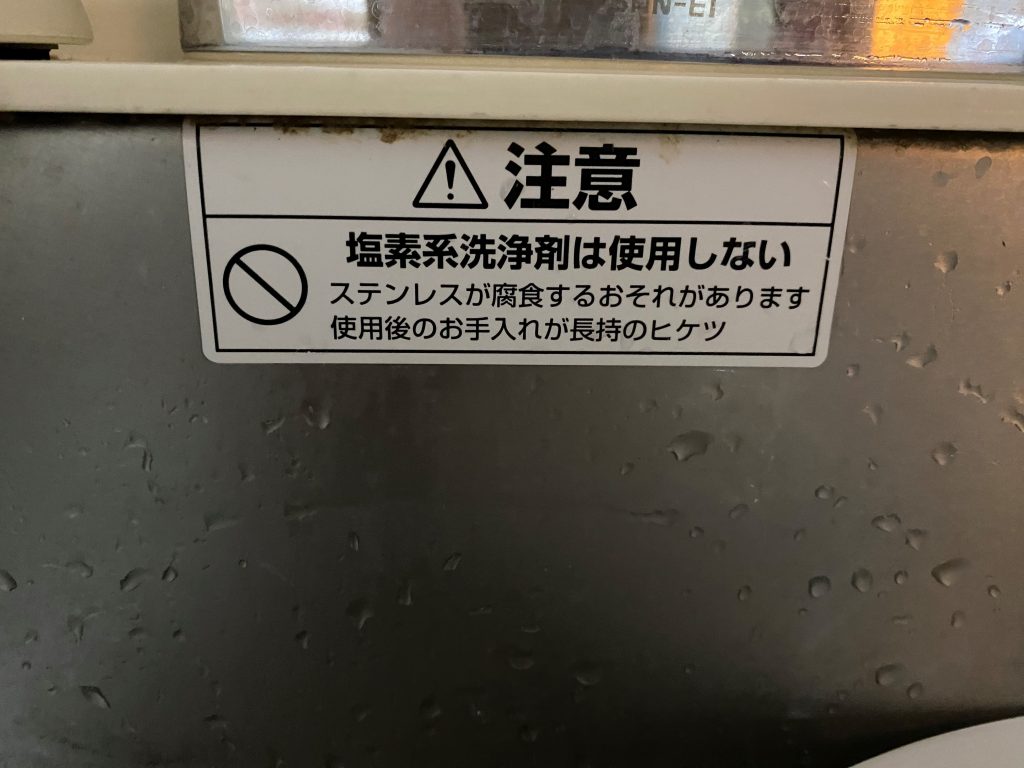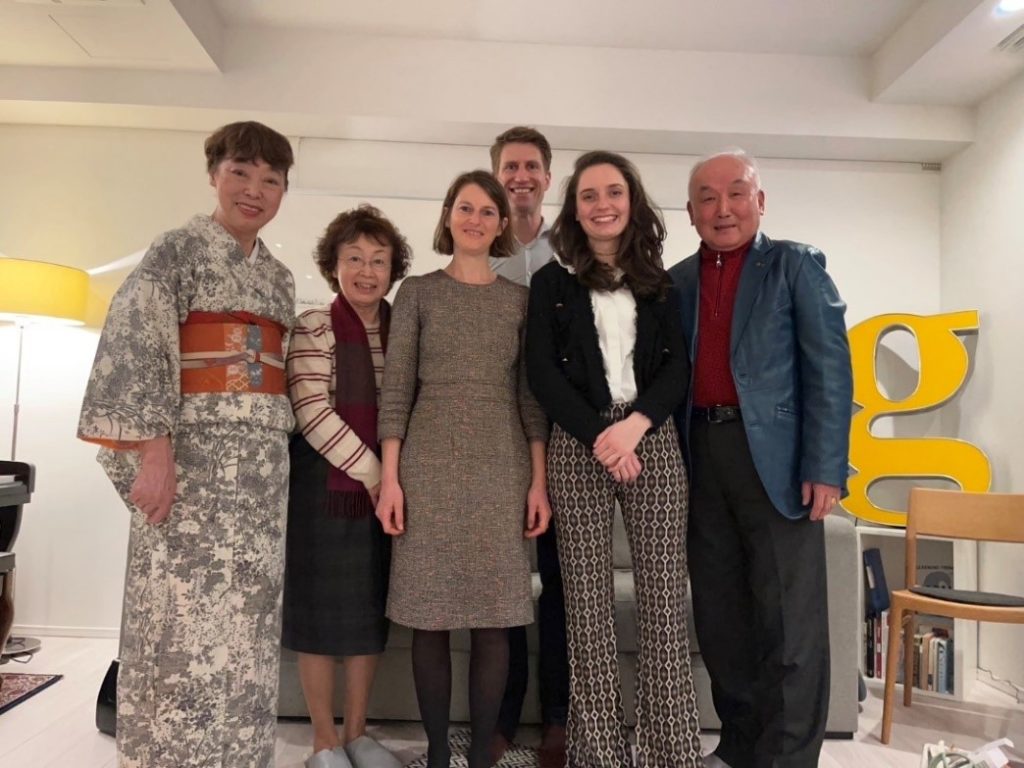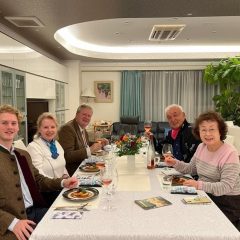☆☆☆first report of Felicitas Künlen, 23rd scholarship holder of the GRÜNWALD foundation☆☆☆

It’s 9,260.84 kilometres (as the crow flies, mind you) from Grünwald in Upper Bavaria to Grünwald in Japan. Or just under 15 hours flying time with the Japanese airline ANA. So even on the outward flight, I’m optimally prepared for my upcoming three-month stay in Japan with the Grünwald Foundation.
Starting with the security check in Munich, where I suddenly find myself in a large group of Japanese students in suits and ties on the flight home, followed by Japanese toilets on the plane, flight attendants who (typically Japanese) bow deeply to us passengers before starting the service or my manga-reading fellow travellers. All these observations shortened my outbound flight on 6 March 2024 considerably. After a stopover in Tokyo-Haneda, I and three heavy suitcases were finally picked up tired but happy by Mr Okamoto at Osaka-Itami Airport on 7 March 2024. Arrival at Osaka airport
Arrival at Osaka airport
At this point, I can reveal to the reader that I have been to Japan before: just 6 weeks after Fukushima, in 2011, and only 12 years old. Together with my family, we were allowed to stay with Mr Okamoto and travelled around Japan. Now, almost 13 years later, I am the 23rd scholarship holder to return to Osaka on my own. Thank you very much for choosing me! It will be exciting to see whether and to what extent the country has changed.
Now just at the end of the first week, I have already been able to experience a lot – starting with many lovely dinners with Mrs and Mr Okamoto (okonomiyaki, sushi, ramen & Chinese). For the rest of my meals, I enjoy strolling through the nearby supermarket, where you can find a variety of great products: from freshly prepared to-go dishes to a large selection of ready-made ramen in colourful paper cups and Hello Kitty skewers for the Japanese schoolchildren’s bento boxes. You can find everything – even Paulaner wheat beer (which I didn’t buy) and Knax Hengstenberg gherkins (which I did buy) are in the range. Bento box accessories
Bento box accessories
My favourite thing to do is to go exploring alone in a city that is still very foreign to me. Because as soon as you have topped up your baby blue ICOCA card with the platypus on it with money, practically the whole of Japan is (more or less) open to you. So my first journey takes me towards the city centre to buy Shinkansen tickets at the ticket counter for other planned tours to Tokyo and Hakuba. Unfortunately, I don’t know where the sumo wrestler behind me in the queue wanted to go. At least he reminded me that I was in Japan.
A visit to a pig café also reminded me of this. On 10 March, I discovered the so-called “hipster district” of America-Mura – a mixture of street art, street food, small independent galleries and cafés. Second-hand clothes, books and records are sold in retro shops. Favourite find in the second-hand clothes shop: a dark blue jacket with the German imperial eagle and Bundeswehr lettering. I went to a “Mipig Café” in order to savour every bizarre thing Japan had to offer. While you sip your vending machine green tea (included in the entrance fee of 11 euros), mini pigs, i.e. small domestic pigs, wiggle around you, squealing happily. They then lie down on a blanket spread over your legs and let you stroke them. It’s a fun experience, but I prefer small dogs… at least they don’t have hard hooves that can bruise you. Vintage jacket with German imperial eagle
Vintage jacket with German imperial eagle Visit in a Pig-Coffee-Shop
Visit in a Pig-Coffee-Shop
The next day was the obligatory visit from the mayor of Suita. In addition to handing over a gift from Bavaria and exchanging business cards (Mr Goto has a really unusual business card for German eyes – a drawing of him with a cat perched on his head), we took photos and talked about skiing and Germany. A very nice visit to the town hall of Suita, in front of whose gate the flags are flying at half-mast today – the reason is the 13th anniversary of Fukushima. In the evening, during dinner with Mrs and Mr Okamoto, we watch old footage of the disaster on TV. Visit to Suita City Hall
Visit to Suita City Hall
12 March – I use this day off again for an excursion around Osaka. Due to the rain, I decided to start by exploring Osaka Station City with its endless corridors and shopping mall. Street food and clothes – although my focus was more on food than clothes – eventually made me bored. “Japan is a country of culture and religion,” I tell myself and decide to visit the nearby temple, Tsuyuten Jinja (Ohatsu Tenjin). The complicated-sounding name translates as “temple of love”. Nestled between monstrously large and grey high-rise buildings, it looks like an oasis, with pink hearts with sayings hanging everywhere. Couples go here to pray for everlasting love. German tourists come here to have their future predicted at a 100 yen machine. The auspicious message flutters out of a red box… although in my case it is less auspicious. The little slip of paper with the number 13 (!) tells me for the future under the heading “Travelling”: “You will waste a lot of money on your journey. Be as frugal as possible”. Under “Relocation”, my oracle recommends “You were better off where you were” and under the “Business” field, it simply ends with “You’ll be a loser”.
Wonderfully motivating words for a Tuesday afternoon in rainy Osaka, I think. On the way home, I accidentally take the underground instead of the suburban train and end up at the other end of the neighbourhood. To make matters worse, I miss the bus by three seconds. That’s the downside of Japanese punctuality: it doesn’t even wait for foreigners walking by and I have to take a taxi to avoid having to wait 40 minutes for the next bus at 8 degrees. So much for point 1, “You will waste a lot of money on your journey”…
 Predicting the future in the temple of love
Predicting the future in the temple of love
At least a man with an owl on his head passes me while I’m waiting for a taxi. At least that lifts my spirits… A man takes his owl for a walk
A man takes his owl for a walk
Another curiosity that always strikes me in Japan is the sheer countless number of warning signs. In my flat alone, I have already discovered eight signs warning me, for example, that the water could come out of the tap hot when I’m showering, that WOMAN could pinch her fingers on the folding chair or that you shouldn’t touch the cooker. I wonder if there is also a warning against a warning? Who knows, there is more in Japan than Western Europeans could ever have imagined.
 Warning in my sink and on my bathroom door
Warning in my sink and on my bathroom door
On 13 March, a very nice dinner awaited me with the Consul General Melanie Saxinger. At her home, her husband Friedrich served creamed mushrooms with bread and spinach dumplings, followed by a Kaiserschmarrn pancake. Despite the advantages of Japanese cuisine, I really enjoy these meals, even though they make me feel a little sad. Is it a feeling of homesickness or do I just miss the food I’m used to eating away from home? Who knows… at least ironing my dirndl and packing my ski gear later in the evening distracts me from it. Dinner with Consul General Melanie Saxinger and her partner Dr Friedrich Kruse
Dinner with Consul General Melanie Saxinger and her partner Dr Friedrich Kruse
Before I leave for my ski weekend in Hakuba (which admittedly wasn’t cheap, keyword: “You’ll waste a lot of money on your trip. Be as frugal as possible”), I introduced myself to the Rotary Club Suita on 14 March. I began my meticulously prepared introduction with the Japanese phrases: “watashi no namae wa fe rishi tas desu” – aka “my name is Felicitas” and a “mungen shusshin desu”, which translates as “I come from Munich”. The slightly puzzled looks from the members sitting opposite me indicate that I definitely need to work on my Japanese pronunciation… At least the bento boxes that are handed out taste extremely good. A guest of the Rotary Club Suita
A guest of the Rotary Club Suita
Back to Hakuba: Hakuba is a well-known ski resort in the northern Japanese Alps in Nagano Prefecture. Hakuba gained international fame when it hosted several events during the 1998 Winter Olympics, including ski jumping and cross-country skiing. Sounds good in theory, but the journey there alone is half a world trip – and not just from Grünwald in Japan. After a train journey of just under 6 hours (from Shin-Osaka to Nagoya, changing trains in Matsumoto and Shinano-Omacho and arriving in Hakuba), I finally reached the famous winter sports resort. The journey took me through the middle of the Japanese countryside, past small villages, factories, small temples and cemeteries, ever closer to the mountains. From the length of the journey, you’d think I was at the edge of the world, where hardly anyone else goes – but you’d be wrong: In Hakuba, a crowd of Australian tourists in shorts are already waiting to storm the mountains. When I ask why they are taking a 10-hour flight to ski in Japan (you could ski in New Zealand too, by the way), the only answer I get is “because of the culture”. How much “Japanese culture” you can experience between the piste and the countless pasta, pizza and burger shops in Hakuba remains questionable. The ski resort also attracts almost exclusively foreigners – my ski equipment is lent to me by an Englishman who has moved to Japan due to the lack of mountains in his home country.
Another interesting fact: there are monkeys here. While you are most likely to encounter monkeys in human form on the slopes when skiing in Europe, in Japan there is the Japanese macaque, also known as the snow monkey. Said snow monkey gave me a good scare on Saturday morning when it peered into my hotel window with interest while I was putting on my ski trousers. To keep my skiing experience short: Snow only good until lunchtime, huts unfortunately relatively uncharming (ramen soup instead of cheese dumpling soup) and the ski lifts are also more of a relic from 1998 than new technology, as one is actually used to in Japan. Nevertheless, after almost 2 weeks in the big city, nature and sunshine did me the world of good. And the ski pass only costs 30 euros!
In the end, however, a nice story happened to me that I don’t want to withhold from the reader and that definitely made this weekend something special: During a descent, a Japanese woman fell in front of me. I collected her skis and helped her to strap them back on. As it was an extremely steep piste, we both spent around 10 minutes before she was finally ready to go again. 2 hours later – I’m happily sitting in my ski lift and want to fasten my rucksack, I’ve just drunk from my water bottle when (every skier’s nightmare, which I’ve luckily been spared so far in my skiing career) – oh, my shock – my poles fall down. Because of all the fiddling around, I only realised later that they were missing…
Two Japanese men immediately approached me on the way out, they had been sitting behind me in the lift, to tell me in Japanese the exact location or mast under which my 4800 yen rental poles had gone missing. Promptly in a cordoned-off area below the lift! The two friendly gentlemen were waiting at the edge of the piste, shouted “Hay” to me and pointed to the spot with their hands. Under their watchful eyes and the entire lift, I was finally able to collect my poles again (embarrassing!).
Why am I telling you about this experience here? – Well, because I believe in karma. And karma works, as you can see. I helped the Japanese woman and the Japanese helped me!
Checking out of the hotel the next day was just as karmic: the receptionist suddenly pulled an envelope out from under the counter, in which – oh wonder – I hadn’t (yet) noticed that it was gone – my credit card. The envelope was neatly labelled: “Credit Card-Felicitas Künlen-Left in the Pub”. I had left it in the restaurant. Friendly and honest as the Japanese are, they had taken it to the hotel, not knowing whether I would even be staying there.

 Skiing in Hakuba
Skiing in Hakuba
The look on the monkey’s face when I’m filming and I’m startled out of my wits – I think the monkey was just as scared…
Sunday evening (17.03) I am treated to a wonderful 12-course dinner. Lots of food – nice conversations and soon the cherry blossom will be here – I think I really like it here!
 Dinner with Mrs and Dr Prof Aoji, Mrs Wada, Mrs Ikawa, Mrs and Mr Shinyo and Mrs and Mr Okamoto.
Dinner with Mrs and Dr Prof Aoji, Mrs Wada, Mrs Ikawa, Mrs and Mr Shinyo and Mrs and Mr Okamoto. 13 previously-same restaurant. Back then with my family.
13 previously-same restaurant. Back then with my family.







